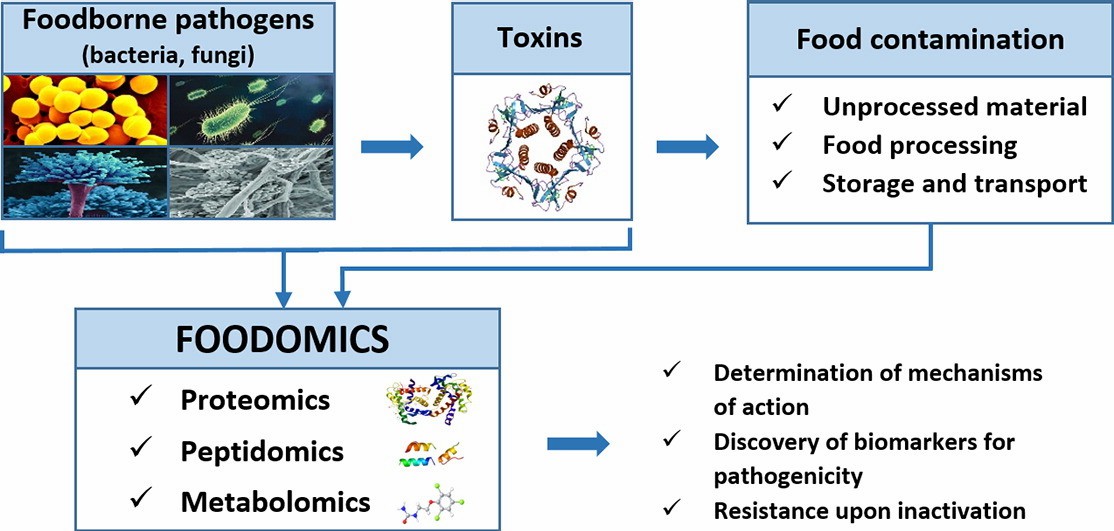Foodborne illness is typically closely relevant to the ingestion of food polluted with pathogens, chemicals, or other substances. In general, these illnesses are divided into two categories, foodborne infections and foodborne intoxications. They can occur when pathogens are ingested with food and multiply in the host, or when toxigenic pathogens multiply in food and produce toxins that are then ingested by the hosts. Numerous factors are associated with the symptoms and severity of food poisoning, such as a weakened immune system and age. Foodborne pathogens have long been a concern for the food and dairy industries.
 Fig.1 Meat-borne disease progression in humans.1
Fig.1 Meat-borne disease progression in humans.1
Foodborne Bacteria
These germs are one of the most widespread causes of foodborne illness and come in diverse shapes, types and properties. Some pathogenic bacteria can form spores, which allows them to survive in harsh circumstances. Multiple bacterial pathogens can cause the illness.
-
Bacillus cereus
These bacteria are one of the main pathogens. They are found in a wide variety of conditions, including soil, freshwater and marine environments. They can form spores that are able to stick to many different types of surfaces and resist removal during cleaning. Due to the formation of sticky endospores, such bacteria widely exist in the food production environment, and then spread to various foods, which in turn can lead to human diseases.
-
Escherichia coli (E. coli)
E. coli are Gram-negative bacteria that comprise a large and diverse group of bacteria. Some strains are harmless while some have the ability to generate toxins that make them pathogenic. These bacteria cause high morbidity and mortality worldwide, and they are transmitted through a great number of vectors, including food and water. Transmission of E. coli occurs when contaminated food or water is consumed. In addition, E. coli can survive in the environment for a long time and can multiply in vegetables and other foods.
-
Salmonella spp.
These bacteria have pathogenic properties and are one of the most prevalent causes of intestinal infections worldwide. Infection usually occurs when eating food that has been contaminated with the feces of animals or humans carrying the bacteria. Salmonella outbreaks are often connected with poultry, eggs, and meat. Of course, these bacteria also contaminate other foods, such as fruits as well as vegetables.
Foodborne Parasites
Parasites are single-celled microorganisms that are usually larger than bacteria. They only reproduce in the host. They are spread in a variety of ways, possibly from animals to humans, humans to humans, or humans to animals. Various kinds of parasites have been reported to be closely related to food-borne and water-borne diseases. These pathogens duplicate in infected hosts. Toxoplasma gondii, Cyclospora cayetanensis, and Trichinella spiralis are the most pathogenic foodborne parasites.
Foodborne Viruses
These viruses are granular in nature and can replicate only in living cells. Therefore, they cannot survive long-term outside the host. Currently, more than 100 enteroviruses have been shown to be strongly linked to specific illnesses, and these viruses are often transmitted through food.
-
Hepatitis A
Hepatitis A can be spread through various means, such as contaminated water, food and environmental surfaces. In addition, such viruses can also be transmitted through direct or indirect human-to-human contact. Hepatitis A, although not able to grow in the environment, however, they are considered to be very stable in environmental conditions, including heat, freezing and desiccation.
-
Noroviruses
These viruses have many properties, such as their ability to withstand a wide range of temperatures and their persistence on environmental surfaces and food, that contribute to their rapid spread. Therefore, preventing infection is very difficult.
If you are interested in our anti-foodborne pathogen antibody products, please feel free to contact us.
You can get more details by clicking the link below:
- Anti-Zoonotic Disease Antibody Products
- Anti-Gut Microbiota Antibody Products
- Anti-Sexually Transmitted Infection Antibody Products
- Anti-Plant Pathogen Antibody Products
- Fermentation Related Antibody Products
- Ali, Sultan, and Abdullah F. Alsayeqh. "Review of major meat-borne zoonotic bacterial pathogens." Frontiers in Public Health 10 (2022): 1045599. Distributed under Open Access license CC By 4.0, without modification.